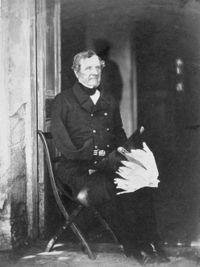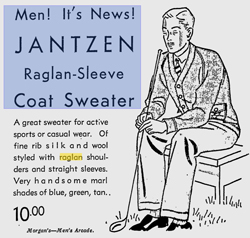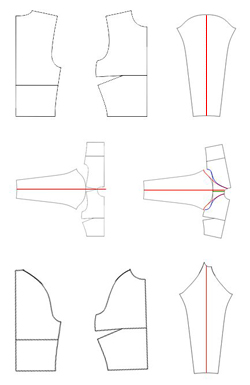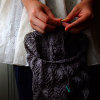 |
During the Crimean War, FitzRoy Somerset, 1st Baron Raglan lost his arm. He was wounded, 5 stab wounds to the left shoulder, at the Battle of Buçaco(1815). To make his dressing easier his tailor invented a diagonal sleeve that exteded from the neck to the underarm. It allowed for the mobility that he needed. It had a relaxied fit that could easily be shrugged off. The Raglan sleeve was then named after him. The Raglan sleeve basically disappears until the early 1900's. Where it appeared again in an add in 1913 for and English Top Coat that was introduced for that fall season. The New Automobile Coat was made of fine wool for the fall season. It disappeared during the war because it the excess fabric needed. Than again in the 1930's Jantzen started to run about men's casual clothing that were styled with a raglan shoulder. (The Montreal Gazette - Apr 3, 1935 page 20)
|
| (Photo from the Wikipedia post on him) | |
 |
|
| So how do you make a Raglan Sleeve - sewing | |
 |
When creating a Raglan in flat pattern making it is rather easy. 1) Trace the front, back and sleeve slopper 2) Lign up the back and front shoulder seams and tape them together 3) Lign up the sleeve 4) Now take your flexicurve ruler and draft a new curve for the back and the ftont. You will want to check that your back and front length are the same. With this processes you are actually creating three new pattern pieces where you are removing a little bit of both the front and back of the slopper bodice is added to the sleeve. 5) Retrace your new pattern pieces and add seam allowances. |
| But the question and the purpose of this post is how do you get a knit raglan that fits, especially if you are plus size? | |
So as we all do, the first thing I did was do a google search. 1) The Incredible, Custom-fit Raglan Sweater So I read there instructions, plugged in my numbers and checked there chart. So for my chest size it told me that my raglan length should be 18 inches. What????? As I thought, that would mean that my armhole would um touch my natural waist. I don't think that would be particuarly comfortable and/or look that great. On a side note, I do think there chart for calculating the stitches around the neck is really clear. Then this got me to really thinking about how they were treating the porpotions for the sweater. It seemed to me that they were treating the body only in the terms of width and assuming the person just got taller with the width. There wasn't a lot of calculation taken into account for the fact that person could be wide. So more Googling.... |
|
 |
2) Then I found: General Guidelines for a Basic Raglan Sweater They broke dow the construction of how a raglan should be broken down for construction. C. The rate that you decrease in the length of C to obtain the correct number of stitches for D from the sum of (A+B)*2 |
| So I continued to do more research.... Now for looking in the books I own... | |
Percentage method - Which still is closer but still a little off for larger sizes it seems. The depth of the yoke is approximately 1/2 of the width of the sweater. So if the body of the sweater is: 32 inches is is 16 inches across and then the raglan would be 8 So I measured several of the commercial raglans I have and the raglans seems to be 10-11 inches on average. They are perfectly comfortable, so I would say that on average you are looking at 10.5 inch raglan. If you want a fitted raglan this method really isn't going to give you a good result. So back to the chalk board.... Not that I am getting obsessed about this. |
|
Monday, August 09, 2010
kitty: raglan obsession
Subscribe to:
Post Comments (Atom)







Who knew? I guess the big question is what advantage it has over other designs?
ReplyDeletehow interesting that it was invented for a medical problem. I must say though, they are not always the most flattering of sleeve styles, particularly for a person with sloping shoulders.
ReplyDeleteKitty, are you planning on a raglan whose front and back are equal height? You may want to look at Knitty's article on sleeves, particularly the section on raglans, where the back is worked more rows than the front, resulting in a different raglan sleeve shape.
ReplyDeleteWell I never! Necessity is the mother of all invention they say. Thank you for that lesson and good luck.
ReplyDeleteTee hee. Rambo is a girl! But she is definitely adorable!
ReplyDelete